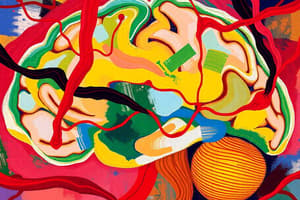Podcast
Questions and Answers
Which condition is indicated when thrombolytic treatment is contraindicated?
Which condition is indicated when thrombolytic treatment is contraindicated?
- Focal cerebral ischaemia
- Ischaemic stroke
- Cerebral infarction
- Haemorrhagic stroke (correct)
What is the primary cause of global cerebral ischaemia?
What is the primary cause of global cerebral ischaemia?
- Severe hypotension or cardiac arrest (correct)
- Extracranial vessel rupture
- Localized blockage of a major artery
- Traumatic brain injury
What is the principle characteristic of focal cerebral ischaemia?
What is the principle characteristic of focal cerebral ischaemia?
- Complete and prolonged ischemia affecting all brain tissue
- Cessation of blood flow to a localized area of the brain (correct)
- Reduction in blood supply to the whole brain
- Diffuse cerebral swelling
Which area of the brain is most at risk during global cerebral ischaemia?
Which area of the brain is most at risk during global cerebral ischaemia?
What is the potential result of severe neuronal injury from a severe ischaemic stroke?
What is the potential result of severe neuronal injury from a severe ischaemic stroke?
How does cerebral infarction primarily affect brain tissue?
How does cerebral infarction primarily affect brain tissue?
Which condition is characterized by a risk of watershed infarcts?
Which condition is characterized by a risk of watershed infarcts?
Which of the following is NOT a typical outcome of mild ischaemic stroke?
Which of the following is NOT a typical outcome of mild ischaemic stroke?
Which of the following is NOT a cause of non-traumatic intracranial hemorrhage?
Which of the following is NOT a cause of non-traumatic intracranial hemorrhage?
What characterizes lobar hemorrhage related to cerebral amyloid angiopathy?
What characterizes lobar hemorrhage related to cerebral amyloid angiopathy?
Which statement about hypertensive intraparenchymal hemorrhage is correct?
Which statement about hypertensive intraparenchymal hemorrhage is correct?
In the context of cerebrovascular disease, what is defined as an episode of acute neurological dysfunction persisting for at least 24 hours?
In the context of cerebrovascular disease, what is defined as an episode of acute neurological dysfunction persisting for at least 24 hours?
What underlying condition primarily contributes to Charcot-Bouchard microaneurysms?
What underlying condition primarily contributes to Charcot-Bouchard microaneurysms?
Which of the following conditions is NOT considered a vascular cause of non-traumatic brain injury?
Which of the following conditions is NOT considered a vascular cause of non-traumatic brain injury?
Which factor is associated with the rupture of small intraparenchymal vessels leading to a hemorrhagic stroke?
Which factor is associated with the rupture of small intraparenchymal vessels leading to a hemorrhagic stroke?
What is the role of systemic coagulation disorders in non-traumatic brain injury?
What is the role of systemic coagulation disorders in non-traumatic brain injury?
What is the primary cause of in situ thrombosis leading to ischaemic stroke?
What is the primary cause of in situ thrombosis leading to ischaemic stroke?
Which factor is NOT a recognized risk factor for in situ thrombosis?
Which factor is NOT a recognized risk factor for in situ thrombosis?
Which type of infarct is typically associated with embolism?
Which type of infarct is typically associated with embolism?
What is the primary pathological change observed in lacunar infarcts?
What is the primary pathological change observed in lacunar infarcts?
Which of the following conditions is characterized by fibrinoid necrosis of vessels?
Which of the following conditions is characterized by fibrinoid necrosis of vessels?
Which of the following statements about thrombolytic therapy is accurate?
Which of the following statements about thrombolytic therapy is accurate?
What is a common presentation of acute malignant hypertension?
What is a common presentation of acute malignant hypertension?
Which statement reflects the effects of cerebral amyloid angiopathy?
Which statement reflects the effects of cerebral amyloid angiopathy?
What type of stroke is characterized by cessation or impairment of blood supply and oxygenation?
What type of stroke is characterized by cessation or impairment of blood supply and oxygenation?
Flashcards are hidden until you start studying
Study Notes
Clinical Manifestation of Brain Injury
- Depends on the site of brain injury, which depends on the vessel involved
Haemorrhagic Stroke
- Rupture of CNS vessels: thrombolytic is contraindicated
- Caused by rupture of small intraparenchymal vessels, leading to sudden onset of neurologic symptoms
- Causes:
- Hypertension (~50%)
- Amyloid angiopathy
- Other vascular causes: vascular malformation, aneurysm, vasculitis
- Other non-vascular causes: neoplasms, systemic coagulation disorders
Ischaemic Stroke
- Cessation/impairment of blood supply and oxygenation
- Types:
- Global cerebral ischaemia: generalised reduction of cerebral perfusion
- Focal cerebral ischaemia: cessation of blood flow to localised area of the brain
Global Cerebral Ischaemia
- Causes: cardiac arrest, shock, severe hypotension
- Area at highest risk: zones bordered by two major arteries → watershed infarcts
- Clinical syndrome depends on severity of insult
- Mild: transient confusion and complete recovery
- Severe: widespread neuronal injury leading to vegetative state or death
Focal Cerebral Ischaemia
- Cerebral infarction: focal brain necrosis due to complete and prolonged ischaemia
- Infarct types:
- Non-haemorrhagic or pale infarct: typically due to thrombosis
- Haemorrhagic or red infarct: typically due to emboli
Non-Traumatic Brain Injury
- Cerebrovascular diseases (CVD): stroke
- Clinical definition: an episode of acute neurological dysfunction presumed to be caused by ischaemia or non-traumatic haemorrhage, persisting ≥24 hours or until death
- Causes:
- In situ thrombosis: atheroma
- Embolism from distant source
- Vasculitis: infection, primary vasculitis
Pathology Changes of Brain Infarct
- Gross pathology and microscopy changes over time
Lobar Haemorrhage
- Affecting cerebral lobes
- Caused by deposition of Aβ amyloid on the wall of medium and small vessels of meningeal and cortical vessels → weak wall → rupture
Studying That Suits You
Use AI to generate personalized quizzes and flashcards to suit your learning preferences.




